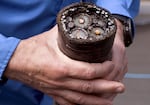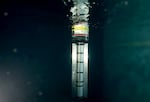Oregon has a massive new wave energy testing facility. But who is going to use it?
July 9, 2025
00:00
/
05:17
After more than a decade of planning, permitting, community outreach, drilling, cable-laying and construction, Oregon is now home to the largest-capacity wave energy testing facility in the world.
Construction on Oregon State University’s $80 million PacWave South near Newport wrapped up this spring. But uncertainty around federal funding for the research and technology development threatens to derail plans to use the facility for testing wave energy converters. At least one wave energy developer initially slated to deploy its technology at PacWave has canceled its testing plans because it lost a federal grant.
Oregon sits on rarefied ground when it comes to wave energy potential, according to PacWave Chief Scientist Burke Hales.
“Oregon is a Goldilocks of wave energy. It’s just right,” he said. “California has coastal infrastructure, but not a particularly good wave climate. Washington has a good wave climate, but not nearly the coastal infrastructure that Oregon has.”
Oregon has a coastline dotted with ports, electrical infrastructure and some of the best waves on the planet for generating energy.

Seven miles out into the ocean off the central Oregon Coast, the PacWave test facility is invisible to the naked eye. It’s a rectangle — roughly 2 by 1 nautical miles — divided into four testing areas.
Beginning next year, companies will begin deploying their wave energy prototypes, connect to a power cable on the seafloor, and track how well their devices convert energy from Oregon’s mighty waves into usable electricity.
“We anticipate the first cable-connected device to be in the water in the summer of 2026,” Hales said. “[Although] some of the political and federal upheaval has thrown some uncertainty into that timeline.”
Under the Trump Administration, grant programs across many science and technology fields have been canceled, and federal funding for research has been eliminated or delayed.
One of the main funders for wave energy technology, the Department of Energy’s Water Power Technologies Office, is expecting a 20% budget cut in the next fiscal year.
Having a place like PacWave to test new technology creates opportunities for wave energy developers. They’ll be able to see how their energy converters perform in real ocean conditions without spending time and money navigating federal and state permitting processes.

“The cost of developing a test site like this is way more than a developer can afford,” Hales said. “Having [the test facility] done ahead of time … basically allows you to focus on what you do best, which is build wave energy devices.”
Even though the idea of converting energy from waves into usable electricity has been around for at least a half-century, the technology itself is still in its infancy. The U.S. government only started giving significant policy and funding consideration to wave energy technology in the past 20 years.
“Really any type of development of technology like this needs that driving force, said PacWave Director Dan Hellin. “They need funding from federal agencies like the Department of Energy.”
Oregon’s wave energy promise
There’s enough available energy in the waves off Oregon alone to power 6.4 million homes — that’s more homes than in Oregon and Washington combined.
“People actually really like the idea of wave energy,” Hellin said. “Lots of people come to the beach. A lot of people live along the coast. They can see and experience the power of the waves. So the idea of trying to capture that energy is a concept they can grasp pretty quickly.”
Some of the most energy-rich waves in the world can be found in the Pacific Northwest. And the enormous untapped storehouse of energy in the ocean makes it an intriguing target to pair with other renewables.
There are waves even when the sun isn’t shining and the wind isn’t blowing. But wave energy technology lags far behind solar and wind.

“If you say a wind turbine, everyone has the same picture in their mind. If you say a wave energy device, there’s such a variety,” said Sarah Henkel, a marine biologist and interim director of the Pacific Marine Energy Center.
Some devices bob up and down in the water and while others hinge on the surface. Some work underwater and some use waves to push air through wind turbines.
“Because the wave devices have a very, very hard time testing at full scale, what you see … is a Rube Goldberg collection of wildly divergent devices,” Hales said.
All wave energy developers face the same challenges out in the ocean — corrosive saltwater, harsh weather, and barnacles and other living creatures trying to make the energy converters their homes.
Then there’s the pesky problem of turning the slow, up-and-down motion of waves into usable power.
Because of the costs, time and bureaucracy involved in bringing new wave energy designs to fruition, no one knows yet what will ultimately become the “three-blade turbine” of the wave energy world. Or even if there is only one optimal design that will work, regardless of the ocean conditions.
“We don’t have the ability to iterate and fail fast. I think we need to be able to do that,” said Alex Hagmüller, CEO of Oregon-based wave energy company AquaHarmonics.
Hagmüller said the PacWave test facility offers a way for engineers like himself to test and improve their designs.
“That’s paramount to moving the industry forward,” he said.
AquaHarmonics was on track to be among the first few companies to get a wave energy converter into the ocean at the Oregon test facility.
But those plans have been derailed.

“We’ve been DOGEd”
At the AquaHarmonics workshop in West Linn in late April, Hagmüller and systems engineer Riley Short were prepping a highly simplified test of the power output of the company’s mid-size wave energy prototype.
“It [would look] kind of like an iceberg. Most of it — three-quarters of it anyway — is underwater when it’s installed,” Hagmüller explained.
The test simulates the up-and-down forces of the waves, but turned on its side in the cluttered workspace of the small Quonset hut so the 30-foot tall device actually fits in the building.
“For this one, we’re going to do a frequency of 0.1 Hz, or a period of 10 seconds. Something in the range of like a 2- or 3-foot wave,” he said.
At this size, the device can provide enough energy to power remote sensors like tsunami warning buoys and high-speed internet anywhere on the open ocean. The highly controlled workshop test confirms those outputs. But they won’t know how truly viable their system is until they test it in the ocean.
They can’t do that without operating funds. The company was waiting for money from an already-approved federal grant to come through, but it never happened.

“We’ve been DOGEd,” Hagmüller said in April, referring to the Trump administration’s Department of Government Efficiency, initially headed by Elon Musk. “Effectively our funding is at a standstill.”
The undelivered funds would have put the company on track to deploy their device at PacWave as early as this September. Hagmüller said AquaHarmonics was in line to be first in the water at the new wave energy testing facility.
On June 30, their current grant window officially ended. On that day, Hagmüller started the process of laying off AquaHarmonics’ small staff.
“It’s been pretty stressful. I’m grieving for us all,” Hagmüller said.
The company’s wave energy converter, which was on the cusp of being tested in the ocean at PacWave, now sits gathering dust in West Linn.

PacWave outlook
In addition to the research grant awarded to AquaHarmonics back in 2022, the Department of Energy awarded $25 million to seven other wave energy converters and applied technology projects designed to prime the pump for eventual open-water testing at PacWave. Two of the companies awarded are currently lined up to begin testing at the Oregon facility over the next couple years.
The company CalWave plans to deploy and connect their device to the grid, feeding power to coastal communities.
And Oregon State University spin-off company C-Power, which has a West Coast office in Corvallis, plans a non-grid-connected deployment.
For PacWave, that’s half capacity. With the lack of clarity and action around federal funding, the adjacent legal turmoil and often-partisan attitudes towards renewable energy, no one knows what to expect the coming months and years.
“We really would rather be working sooner,” said chief scientist Hales. “It’s not free to keep the site viable. We have to maintain our staff. We have to maintain maintenance and monitoring of the facility.”
Those maintenance and monitoring costs accrue whether or not the facility has paying customers with wave energy converters in the water.
But with a project that’s already taken more than a decade to come online, success is going to be measured in different ways. For Hales, that’s having wave energy converters deployed at PacWave feeding megawatts of energy back to the grid.
For marine biologist Henkel, it means having all four testing berths at PacWave fully occupied by 2030.
“Five years from now is just one federal administration away,” she said.
Search
RECENT PRESS RELEASES
Related Post
